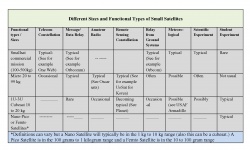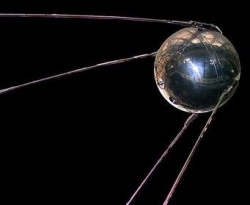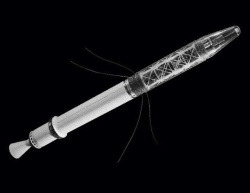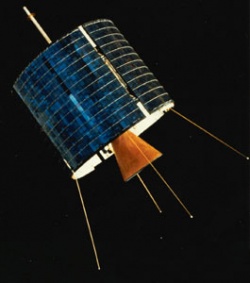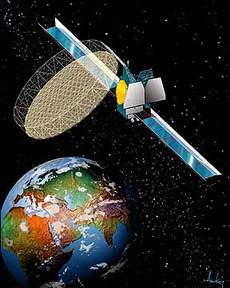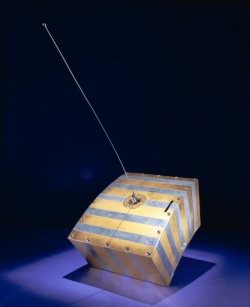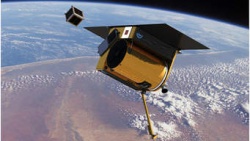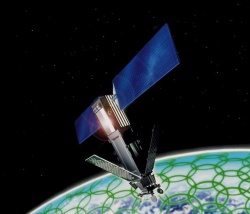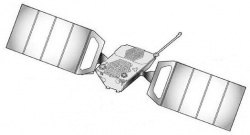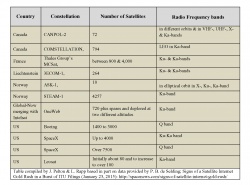The Farthest Shore – Chapter Seven The Small Satellite Revolution
From The Space Library
Chapter Seven The Small Satellite Revolution
Joseph N. Pelton
The world of space and space applications is exciting for many ways. One of these ways is that the space industry is highly dynamic and new entrepreneurial ventures can, over the course of a few years, alter the entire course of the space industry. Two of the most dynamic areas of change in the so-called “new space” industry today are the advent of new privately-developed launch systems and the small satellite revolution. This chapter is about the various ways that small satellites of various kinds and characteristics are making significant changes to how satellites, and indeed satellite systems, are designed, manufactured, deployed and operated. It also addresses some of the “growing pains” that have accompanied the small satellite revolution such as very real concerns about proliferation of orbital space debris.
The first thing to address is the very ambiguous label of small satellites. It turns out that a “so-called small sat” can cover something as little as a “Femto-sat” with a mass of 10 to 100 grams up to a commercial small satellite in a large communications constellation with a mass of 500 kilograms or more. This represents a gigantic mass ratio of 1 to 50,000. Clearly the term “small sat” is ambiguous and its use can be misleading and lead to confusion. The following chart (See Table 7.1) seeks to provide some form of “typology” for the very broad types of uses and sizes that can be classified as a “small sat”. To know what you are really talking about you need to know the mass and dimensions of a small satellite as well as its orbit, its mission, frequencies, lifetime and degree of maneuverability and any de-orbit capability either active or passive in nature.[1]
As can be seen in Table 7.1 there are many different types of small satellites designed and built for a wide range of issues and with a wide range of sophistication in their component parts, pre-launch testing, reliability and functionality. There are essentially three generic categories of small satellites that are useful to consider and analyze. These are three types with sufficient similarities to consider usefully as a group are: (i) student experiments and projects like amateur radio; (ii) small satellites in the 1unit to 6 unit cube sat range designed and built with a high degree of engineering rigor which are intended to be used for new types of commercial services or serious scientific experiments and governmental observations and measurements (iii) serious commercial ventures that are deploying low or medium earth orbit constellations will heavier-type small satellites and reasonably sized antennas and power capabilities that are intended to compete with larger multi-ton satellites deployed in geosynchronous orbit. These three classes vary significantly in cost, launch operations, pre-launch test, mass, and de-orbit planning and capabilities. Thus, the analysis will be broken down in this manner, but first it is important to understand a bit of the his-torical background and the evolution of the space industry that has brought us to today’s global space environment.
7.1 Historical Patterns of Spacecraft Design, Manufacture and Launch
At the beginning of the space age spacecraft design and manufacture was an activity reserved for national space agencies and large aerospace industries accustomed to working on very sophisticated and quite costly programs. When the Outer Space Treaty was adopted in 1967 it was generally thought that all space activities would be controlled by space agencies and military space commands.
The satellites were that were first designed and built involved teams of scientists and engineers with high levels of expertise in many disciplines. Design reviews considered every aspect of the spacecraft design, subsystems were analyzed and tested for reliability and possible reductions in size and mass. There were also arduous testing programs designed that included shaker tables, thermal vacuum chamber tests, testing of antennas on ranges and anechoic chambers. The in-space deployment of satellite equipment that had been stowed for launch inside of the rocket’s nosecone such as antennas, solar cell arrays, and other components that had to be unfolded in the space environment were tested over and over again. Many spacecraft were designed for specific tasks and were produced in small numbers such as three, four, five or six spacecraft.
All these early approaches to the design, manufacturing, testing, deployment, and operational implementation of spacecraft were quite expensive. Spacecraft manufacture involved a considerable amount of time, involved a large number of highly salaried and expert personnel, and required specialized equipment and large and costly facilities such as specific electronic testing equipment, clean rooms and high bay areas. These facilities involved capital investment in the many millions of dollars. On top of all of this, launcher arrangements were very expensive, required specific design of spacecraft to withstand the vibrations and stresses associated with launch such as so-called “pogo effects”, and were not necessary all that reliable.
This possibility of frequent launch failures meant that both the spacecraft and launcher could be lost and this in turn meant that launch insurance was difficult to obtain and was also expensive. The bottom line was that spacecraft and launchers were very costly to obtain and involved long lead times to build of perhaps three to four years. As a result of all of these factors participation in building and launching a spacecraft was totally not available to students, amateurs, or anyone outside of well-funded governmental space agencies or very large and sophisticated commercial space organizations such as Intelsat, Inmarsat, or Eutelsat. For a significant amount of time U.S. and Soviet Union launchers were the only available rockets available for space programs on a global basis.
The first satellites that were built and launched at the dawn of the space age such as Sputnik on October 7, 1957 (83.6 kg),[2]Explorer 1 on January 31, 1958 (14.1 kg)[3], Intelsat 1 (or “Early Bird”) on April 6,1965 (149 kg)[4]were actually what might be legitimately called “small satellites” since their launch mass were all under 150 kilograms. (See Figures 7.1, 7.2 and 7.3).
This outer space environment that was controlled by space agencies (especially NASA and Roscosmos), military commands and large aerospace companies largely held from the late 1950 through the 1980 and to some extent even into the 1990s. In this environment, satellites and spacecraft grew larger, more capable, with higher and higher capacities. Each generation of spacecraft tended to increase by a factor of 2 or so in mass and its throughput capabilities or sensor resolution increased by a factor of 5 to 10. Commercial High Throughput Satellites (HTS) today such as Via-sat 1, Intelsat’s Epic 1 and 2 or Echostar’s Jupiter might have a mass of about 10 metric tons but in terms of throughput and lifetime might be up to a million times more capable.
The key thing to understand about the half century evolution of spacecraft—and communications satellites in particular—has been the pattern of “technology inversion”. This means that communications satellites have become larger, more capable, with larger and more powerful antennas, and yes, more costly. But this change has allowed users on the ground to access satellites with only cellphone sized satellite hand phones or transceivers the size of a laptop to have broadband access to satellites. No longer are their satellite ground stations that are 20 tons in size with a 24/7 staff of perhaps 70 people to operate them. That is why spacecraft for communications deployed in GEO orbit have become so large and complex with gigantic antennas more than 20 meters in diameter. The Thuraya spacecraft built by Boeing is typical of gigantic spacecraft deployed in Clarke orbit that now provide mobile communications services to handheld units. (See Figure 7.4).
A number of things, however, began to change in the 1990s. First of all a number of other countries began to develop their own launch capabilities. Arianespace together with the European Space Agency developed a reliable set of Ariane vehicles. Japan, India and China followed suit. Today over a dozen nations have developed launch capabilities. In addition there are a growing number of commercial ventures that are developing so-called “New Space” launcher systems. These new commercial systems are growing more cost effective, more reliable, and able to support a wide range of launch options—including launch systems optimized for smaller spacecraft. The latest development by commercial launcher companies is to develop reusable or partially-reusable launcher systems that are potentially much lower in cost and perhaps much more reliable. These projects, just to name a few of these efforts, include those of Space X, Blue Origin, Swiss Space Systems, Launcher One, Stratolaunch, and Skylon by Reaction Engines.
But not only are launch costs coming down, there has been a revolution involved in spacecraft design as well. Ironically, the technology that has allowed hand held satellite phones to operate with large satellites has led to new capabilities and technologies to design and build smaller spacecraft as well. The key, in many ways, are what are called application specific integrated circuits (ASICs). These super capable computer chips always the design and wholesale manufacture of smart phones that can do many things. One ASIC chip in a smart phone allows GPS navigation. Another chip allows broadband cell phone communications or even handheld satellite phones. These amazingly compact electronics, computer processors, software and encoding systems can now be included in innovative new satellites, themselves to make them smaller and more capable.
Ironically satellites have grown from small to large and complex and thus enabled small and compact ground systems for mass consumers. The irony is that new compact ground systems technology, such as ASICs are now being reapplied in space to allow the creation of new “smart” and compact spacecraft. A technology cycle has now come full circle.
7.2 Small Sat Student Experiments and Amateur Project
The rapid development of computer processors, sensors, and electronics that are extremely compact and with a high degree of functionality over the past two decades represent the enabling technologies that make small sats and especially cube sats now not only possible but economically attainable for many projects. Miniaturization of digital cameras and sen-sors along with digital processes and ASIC technology have allowed many new advances in small satellite design and manufacture. Along with this so-called “cubesat” revolution has also come a wealth of new options for cost effective launch of small satellites as well.
The first phase of the small satellite revolution could perhaps be said to have started with amateur radio enthusiasts who were also engineers who worked together to design and build a small satellite that they called OSCAR. OSCAR 1 was indeed put together by a group of enthusiasts who collaborated to have this small ten kilogram satellite launched into a highly inclined low earth orbit of 81 degrees. This orbit allowed the satellite to provide intermittent coverage of the whole world. This satellite as pictured below was launched December 12, 1961 by a Thor-DM21 Agena B launcher from Vandenberg Air Force Base in California. The small satellite was essentially a rectangle and had the dimensions of 30 x 25 x 12 cm (12 in x 10 in x 5 in).
This was essentially free launch in that it was arranged as a “piggyback” operation whereby OSCAR 1 represented essentially ballast for the secret surveillance satellite launch then called the Corona 9029 mission. This at the time super-secret Corona “spy satellite” was also known as Discoverer 36. It represented the eighth and final launch of a KH-3 satellite. OSCAR-1 was not only small and had a very low mass, but it was also designed by volunteer engineers using available parts rather than specially designed and tested satellite components. Further, it was launched as a secondary payload using the excess lift capacity of the Thor-Agena launch vehicle.[5]
Thus, in many ways OSCAR-1 constituted the “intellectual grandfather” of many small satellites that are built by students at colleges and universities for launch today. The heritage characteristics still found in student experimental small satellite projects are: (i) compact size; (ii) low mass; (iii) typically use VHF frequencies; (iv) use of off the shelf components wherever possible; (v) no extensive pre-launch testing program; and (vi) use of “piggy-back” launch operation, essentially as ballast in the launch of a much bigger payload and use of an orbit of convenience. (See Figure 7.5).
The next key step forward was the creation of university-based centers that have developed a high level of expertise in the design and building of small satellites. The key facility in this regard was the one created some thirty years ago by Professors Barry Evans and Martin Sweeting at the University of Surrey in the United Kingdom. This academically based effort has evolved over three decades into what is now known as Surrey Satellite Technology Ltd. (SSTL). SSTL is now a full-service facility globally known for its ability to design, build and arrange for the launch of small satellites. It has gone well beyond the University of Surrey based group that in the 1970s began to put together commercial off the shelf (COTS) components to design and build small satellites. By 1985 it was decided to create a spin-out company known as SSTL led by Sir Martin Sweeting.
Today it is not only a commercial entity separate from the University but, in fact, is now owned by the Air Bus Air & Defense Space Group. Its web site notes it has built a reputation as “the world’s premier provider of operational and commercial small satellite systems” as it has gone well beyond the initial scope of activities of just designing university-based satellites through the efforts of faculty and students. Today SSTL has designed, built and arranged for the launch of 49 small satellites and is working on many more satellites and has assisted many countries in the design and building of their first satellite.[6]SSTL’s advertised services now include:
- Provide complete in-house design, manufacture, launch and operation of small satellite
- Deliver complete mission solutions for remote sensing, science, navigation and telecommunication
- Deliver space training and development programs including on-the-job customer training
- Design and build remote sensing and communications payload
- Supply avionics suites and subsystem
- Build and install ground infrastructure
- Provide consultancy service
Thus, SSTL now works on many projects as a supplier to space agencies and national governments as well as assisting with university-based and commercial projects around the world.[7]
Other programs have emulated what the University of Surrey began in the 1970s. Utah State University in the United States has provided leadership in developing a small satellite developmental effort and also sponsors an annual conference dedicated to the design and building of small satellites. The Small Satellite Program at Utah State University (USU) has a key relationship with the Space Dynamics Lab (SDL) that is located in Logan, Utah. This USU Small Satellite Program is capable of designing a range of small satellites and scientific experiments. The USU Small Satellite Program web site notes that it is now capable to provide a full range of services that move from concept to full fabrication, test and flight.
The Small Satellite Program team is made of faculty members and aerospace engineering students that work in close collaboration of professional engineers at Space Dynamics Laboratory to actually design and build small satellites and arrange for their launch.[8]
Services that are offered at the USU Small Satellite Program include:
- Development of a modular micro-satellite platform at USU/SDL that can be readily adapted to multiple missions.
- Creation of specific small satellite platform that can be fabricated in essentially a year’s time at low cost through the use of academic, semiprofessional and some professional staff members from SDL.
- Creation of specific sub-system hardware for power, thermal control, deployable mechanisms, telecommunications, remote sensing, or scientific missions that can easily be integrated into small satellite mission platforms
- Provide for integration services for the overall small satellite mission to meet all international launcher standards.[9]
There are now many university programs that are involved with the design and launch of cube satellites and indeed one can order basis cube-sat platforms with 1unit through 6 unit configurations. Currently in the United States there is an annual University Nanosat Competition. Currently the Fourth University Nanosat Competition is underway in 2016 and 2017 and there are 11 universities formally entered. This Nanosat IV program is sponsored by the U.S. Air Force Office of Scientific Research (AFOSR), NASA Goddard Space Flight Center (GSFC), the American Institute of Aeronautics and Astronautics (AIAA), and the Air Force Research Laboratory—Space Vehicles Directorate (AFRL/VS). Winners of this competition in past years have come from Cornell University, University of Texas Austin, University of Colorado-Boulder, Arizona State University, and New Mexico State University.[10]
There are, of course, a growing number of universities around the world that have active cubesat or small satellite design and build capabilities. Most of these programs are aim at designing and building scientific experiments but they also are in some instances focused on designing remote sensing, communications, or other practical application satellites that might be deployed as low earth constellations.
Even more recently there are programs that are aimed at bringing small scale space science projects to middle school or high school level students. These preschool projects can be set up in a variety of ways. One initiative carried out by the National Center for Earth and Space Sciences Education (NCESSE) and by the associated Arthur C. Clarke Institute for Space Science Education is to hold competitions involving schools in the U.S. and other countries participating as partners in the International Space Station. Many schools sign up and submit plans for space experiments that can be conducted on the International Space Station where participation is enable through the Nanoracks Corporation. Nanoracks works in concert with NASA and other ISS partners to offer the opportunity for student space experiments.
One option is to use the Japanese module designed to launch cubesats into low earth orbit from the International Space Station. The other option is for very small-scale experiments to be conducted on board the ISS in the on-board Nanoracks experimental station. Astronauts, as part of their onboard duties can switch on and off experiments and activate switches or take readings necessary to complete these student experiments. Students in various schools sign up for the competition, design and specify the details of an on-board experiment. Students from the selected schools actually build with technical assistance these small-scale experiments that actually fly on missions. A set of 17 experiments going to the Nanoracks test bed were unfortunately destroyed in the Orbital ATK Antares-Cygnus Commercial Operational Transportation System resupply mission to the ISS on October 28, 2014. NASA, however, made arrangements for these student experiments to be recreated and to fly on the next resupply mission.
Although these student projects are interesting and inspiring for students with an interest in science and space, they have given rise to issues. One issue is the need for all nanosatellites that are launched into space to be registered with the UN Office of Outer Space Affairs as required by the Registration Convention. Thus, governments must make sure that the proper registration procedures are followed. Also, there needs to be instruction to students and engineers without detailed knowledge of space conditions to make sure that student cubesat projects are properly designed. The use of commercial electrical wiring for instance can create resistance levels that can lead to fires and thus present a safety hazard on board the International Space Station. Safety briefings and basic space craft engineering courses must be provided to ensure that key safety standards related to such issues as hypergolic fuels, battery design, wiring systems, command systems, etc.
Finally, there is the concern about the buildup of space debris associated with student small sats. The prime answer here has been to ensure that student small sats are typically put into sufficient low orbit that they decay due to gravitational effects in a reasonably short period of time. There have been efforts to combat orbital debris via such means as encouraging experiments to be carried out on the ISS rather than as free flyers and then the experiments brought back on return missions or simply to burn up in the atmosphere on the return such as on the Cygnus capsule. Another proposed option has been for student experiments to fly on a platform that carries many experiments at once so that all of these experiments can be returned together via a controlled active de-orbit system. Yet another option that has evolved has been for student experimental satellites to include light weight passive de-orbit systems such as end of life balloons, sails, nets or tethers that can be deployed to accelerate the de-orbiting process. Some of the more recent small satellites have included miniature alcohol-fueled jets that can assist with orientation and end-of-life deorbit.[11]
As can be seen by the above narrative the world of university-based small satellite programs and amateur small satellite projects such as the OSCAR projects that have come from the American Radio Relay League and new small satellite projects for commercial space programs that are deploying very small spacecraft in the 1 unit to 6 unit cube sat class is very real and pertinent.
7.3 Commercial Space Programs for truly Small Satellites (1 unit to 6 unit spacecraft)
There are now a growing number of small satellite constellations that are been designed by young enthusiasts who feel they can essentially break with the “rules of satellite design and manufacturing” of the past and create capable systems for a fraction of the cost of spacecraft systems of the past. Typical of these new commercial cube sat-based systems are the Skybox remote sensing system that has been acquired by Google and renamed Terra Bella. The four founders of Skybox, graduates of Stanford University quickly made the transition from graduate students to multi-millionaires.[12]Another exciting new venture was hatched out of Silicon Valley by graduates of the International Space University. This venture was initially called Planet Labs and now is simply called “Planet”.[13]Even more recently Google sold Terra Bella to Planet so that this small satellite venture for remote sensing now dominates this part of the global market with over 150 “Doves” now in orbit. (See Figure 7.6).
These small sat commercial systems for remote sensing use high performance and miniaturized sensors that allow imaging from quite small satellites. The deployment of a large number of cube sat sized satellites in low earth orbit deployed rather randomly rather than in traditional sun synchronous polar orbits has dramatically decreased launch costs—with many of Planet’s “Doves” simply being pushed out of the Japanese module on the ISS. The “value added” of small sat systems is not higher resolution images, but rather frequently updated information and acceptable levels of pixel resolution at much reduced cost. This new entrepreneurial space industry is clearly another example of the “computer world” that is focused on better, faster and smaller meeting the traditional space business world and finding disruptive new solutions.
Several aspects of these cube sat based commercial ventures and the constraints that they face should be considered as follows:
Small Satellites Are Better at Some Applications than Others: Very small cube sat operations are much easier to achieve for remote sensing and earth observation since sensors for this purpose can be greatly miniaturized. The same is not true to the same degree for communications satellites. This is because high gain antennas and their performance are directly proportional to the square of the antenna reflectors. This is due to the law of physics. Also broadband communications and high throughput requires power and this also drives size upward.
Small Satellite Constellations Are Useful in Providing Rapid Updates: A large network of remote sensing satellites that can provide updates on the same location every 2 to 4 hours has value in noting changes that are occurring such as the number of cars parked in parking lots, changes to flooded areas or even spreading of oil spills. Many commercial applications by farmers, surveyors, urban and transportation planners, or police, firefighters or environmental monitors do not depend so much on high resolution images as quickly updated images. Terra Bella and Planet Labs see themselves as serving markets that include agricultural and forestry, civil government and defense agencies, energy and mining, finance and business intelligence, insurance industry, mapping and surveying, and policing and environmental enforcement, among other sectors.
New Launch Options for Small Satellites: The advent of commercial cube satellite type systems has stimulated the market for new launch operations. One key innovation has been the Japanese module that allows deployment of cube sat sized spacecraft. A number of the new commercial space plane developers also have plans to provide options for small satellite launches. There are also several new entrepreneurial companies that are being designed to launch quite small satellites. Although most of these efforts are aimed at supporting small satellites for telecommunications and networking that are of significantly larger with greater mass, they could also be used to support cube sat launches as well. These new launch options will be discussed in the following section.
Small Satellites for Instant Communications Require Large & Ordered Constellations: A reasonably small constellation of cube sats can support 2 hour to 4 hour daily updates around the globe for the purpose of remote sensing. This can be done effectively even with a randomly deployed network. For telecommunications such a network can really only support delayed machine to machine (M2M) data relay, but not support instantly linked telephone or video connections. A number of Surrey designed small satellites have supported data relay networks starting with the two satellite Lifesat system that relayed text messages from remotely located clinics and doctors in Africa in the 1980s but required many hours to complete a two-way message. In short larger spacecraft in an extensive, ordered and controlled network with more power and larger antennas are needed for instant global connectivity.
7.4 Commercial Space Craft Deployed in Large Scale Constellation
Well before Terra Bella or Planet burst onto the scene, the idea of deploying small satellites in a Leo constellation to support commercial global communications made its appearance in a number of systems in the 1990s. Several “firsts” in this regard are notable.
7.4.1 Orbcomm: The first commercial data relay or business to business (B2B) small sat constellation
Orbital Sciences conceived of a network of satellites to support data relay services on a world-wide basis in the late 1980s and filed an application with the FCC to deploy a constellation of small satellites in 1990. After receiving approval of the needed frequency allocation for the service at the World Administrative Radio Conference (now known as the World Radio Conference) in 1992, Orbital Science initiated the actual design and construction of the needed small spacecraft for the constellation. This was, in fact, deployed in a series of launches between 1996 and 1999. [14]
This system was known as Orbcomm and was envisioned as a network to be used in conjunction with GPS satellites for fleet operators to keep in touch with buses, large trucks, ships, and even rail operations. The satellites were launched by Orbcomm’s small Pegasus launchers that were lifted to high altitude and then launched after being released from the aircraft. This venture had a number of partners that primarily included Orbital Sciences and Teleglobe Canada. The expense of the system and a lack of sufficient customers ended with this system declaring Chapter 11 bankruptcy in September 2000. A new group of investors bought this system out of bankruptcy on April 23, 2001 and it has been operational and financial successful since that time with a stated customer base today of over 1.5 million users and with a second generation of satellite now fully deployed. The first-generation satellites had a mass of only 42 kg (93 lb). These satellites which could be stowed in a very flat and compact manner and could be launched several at a time. Of the first-generation satellites 35 were deployed in orbit and 24 are still operational. (See Figure 7.7).
The second generation of satellites which are significantly more capable have a much larger mass of 172 (379 lb). These second generation Orbcomm satellites are launched on SpaceX Falcon 9 vehicles. Although these satellites are clearly much larger and capable than Cube Sats, these are definitely small satellites in comparison to the multi-ton satellites deployed in GEO orbit.[15]
During this same time frame a U.S.-Russian project known as “Courier” was also initiated into detailed planning and engineering in the early 1990s. The intent was to create a global data messaging constellation of small satellites that would grow in size and capability so that it could in the second phase also provide mobile voice services. This project was cancelled by its primary financial backer Charles Butcher of Boulder, Colorado because of both technical and business reasons. [16]
7.4.2 Iridium: The first small sat constellation for global mobile satellite communication
Motorola with a large group of global partners were to first to file to create a truly global mobile satellite telephone and data services using handheld transceivers for land, sea or even air communications. This system known as Iridium (atomic number 77) was initially to have 77 satellites (11 satellites in 7 planes) but ended up with 11 satellites in six planes. This small satellite constellation for global mobile communications was first conceived in 1986 but not deployed until 1996 and 1997 over a decade later. Enormous gains in cellular communications systems that by 1998 had many more cell towers, sent out more powerful signals can could operate effectively to cars and homes served to undercut the financial viability of this network that ended in bankruptcy in 1998. [17]
The Motorola satellites at 689 kg and deployed in nearly polar orbits with inter-satellite links and phased array antenna systems were highly sophisticated for their time, but still constituted “small satellites” in comparison to the geosynchronous communications satellites being deployed at that time that were an order of magnitude larger in volume, power and mass. Technically these satellites were very capable and more than half of these satellites are still operational nearly two decades later. The second generation, known as Iridium Next, is being currently implemented.[18](See Figure 7.8)
7.4.3 Globalstar and ICO: The other early small sat constellations for global mobile sat service that failed
There were two other filings to create small satellite constellations in low earth orbit that were close on the heels of Iridium. These were the Globalstar LP system that was backed by Space Systems/Loral as filed in 1992 and the ICO system that was envisioned as a spin-off of the Inmarsat organization headquartered in London that also filed for service with the ITU in 1992. The Globalstar small satellites in the first generation were only 550 kilograms. These were deployed in a higher orbit (i.e. 1414 km) than Iridium and only covered the Earth between 52 degrees North and 52 degrees South.[19]This allowed the system to operate with only 40 satellites that was expanded to 48 satellites in 2007 after it had emerged from its 1998 bankruptcy. (See Figure 7.9)
The ICO system as initially envisioned was never deployed because the 1998 bankruptcy filings of Iridium and Globalstar strongly signaled that the global land mobile satellite businesses had to be re-envisioned in terms of customer base and its competitive stance vis a vis the terrestrial cellular business. Iridium and Globalstar, as reorganized and with new ownership, are now providing global services to millions of users and are deploying second generation constellations.
7.4.4 The Revolutionary Teledesic Small Sat Concept: A huge con-stellation for broadband fixed satellite services using Ka-band Fre-quencies
At essentially the same time as Iridium, Globalstar and ICO came the most ambitious of all the initiatives for a small sat constellation. This was known as the Teledesic satellite system. This gigantic small sat system, code named “The Calling Communications Satellite System”, was first announced in 1994 as a global communications network. This system as initially conceived by James Stuart and a team of engineers at the University of Colorado Boulder campus. The concept was to deploy a totally new class of small satellites in a LEO constellation. The plan was to “mass produce” these new small sats like video cassette recorders in order to form a “MEGALEO” constellation of 840 satellites plus 80 spares. Further it was to operate in the never before used for commercial satellite service Ka band (i.e. 30 GHz uplink and 20 GHz downlink) Ka-band. This innovative project was a truly daring project that received widespread publicity because it was financially backed by Microsoft’s Bill Gates and cell phone magnate Craig McCaw as well as backers from Saudi Arabia. Actually, this was a project first begun by venture capitalist Ed Tuck of California who financed the early design work by James Stuart and his team. This project subsequently went into serious design and implementation work with lead efforts from SAIC and with Boeing Company as the satellite manufacturer. But this system was never to be. When Gates and McCaw pulled the plug on this project it ended in bankruptcy as well.
The multiple bankruptcies comprised of Orbcomm, Iridium, Globalstar, ICO, and Teledesic, and the largely unrecorded stoppage of the Courier project in Russia, it really created a red flag for other large-scale constellations. A number of Ka-band commercial satellite systems filed with the FCC during this time ended as paper satellites. Ultimately the Blue Skies (Ka-band) satellite was the only one actually deployed and this was a large scale traditional architecture GEO orbit satellite system and not a small satellite constellation.
The initial financial problems associated with small satellite constellations dried up capital financing. This put a stop to any further small sat constellations getting off the ground even though there had been filings at the FCC in the US and in other countries of plans to build other types of small satellite constellations for data relay, mobile satellite services to land-based users, and even high data rate fixed satellite services. This experience let to over a decade long hiatus on small satellite constellations development.
Over time, however, Iridium and Globalstar, after being reorganized out of bankruptcy and with new ownership and management showed that viable businesses could be built using small satellite constellations. These small satellite constellations of the 1990s and early 2000s, however, were clearly of a different breed that today’s small satellite systems like Terra Bella or Planet. All of the small sat constellations of the 1990s were conceived, designed, built and/or launched by established U.S. and European satellite manufacturers and launch service providers who used high end test facilities as well as well-compensated engineers and scientists. These manufacturers were nevertheless innovative and help pave the way for the small satellite constellations that are planned or underway today. These early systems such as Iridium and Globalstar did manage to master the art of high volume production and lower cost manufacture. Indeed, Motorola at the end of their production run of 100 Iridium satellites were producing a complete new satellite every 4 days and they had greatly streamlined their testing regimen to be much more time and cost efficient. Yet still these early generation small satellite constellations were still highly sophisticated and expensive spacecraft that were also still costly to build, test, and launch. They were still quite a bit removed from today’s small satellites that use off-the-shelf components and young, just out of college, engineers for system design. These new type satellite constellations, born of Silicon Valley, were thus often first designed and built in a garage and not a high-end satellite production plant. The most innovative of these new small satellite products were tiny spacecraft that range in size from 1 unit up to a 6 unit cubesat or not much larger. Contemporary small satellites are now frequently costing a tiny fraction of the price of the small sats of the 1990s and they are two orders of magnitude less in mass than say an Iridium or Globalstar spacecraft. Today’s small satellites might weigh 5 kg as opposed to about 550 kg for a Globalstar satellite or 689 kg for an Iridium satellite.
The caveat to bear in mind here is that remote sensing satellites, where miniaturization is possible in almost every aspect, are easier to reduce to cubesat dimensions than is the case with communications satellites. With comsats, stabilization, high gain antennas and more power requirements do push the satellites to larger dimensions even when deployed in low earth orbit constellations.
7.5 The new LEO sat constellations for Internet and high data rate data relay
The latest evolution in small satellite concept and deployment is with regard to communications and high-speed data access systems optimized for broadband Internet access. It is here where the similarities diverge considerably. Some of the proposed systems are designed and optimized for coverage of developing countries and the equatorial region and others are not. Indeed, some such as the proposed “Leosat” constellation is explicitly being designed to serve corporate customers at very high throughput rates and seemingly intent on not serving developing countries. Google at the most extreme design concept has discussed the deployment of high altitude balloon systems that would service developing countries via is “Loon” system. Table 7.2 seeks to summarize some of the various small satellite constellations that have been proposed to provide broader band networking optimized systems and which are designed to be deployed in low earth orbit as of September 2017. The number of filings for such systems continues to mount and many industry analysts question whether all of these systems can be economically successful, and even more so worry about the implications of orbital space debris spirally out of control if there should be collisions with these systems as the number of small satellites escalates.
Despite the many proposed small satellite constellations seeking to provide data networking services from low earth orbit using small satellite constellations, there is, as of mid 2017, only one system that has secured key financing, has awarded contracts for satellites currently under construction, and also has signed contracts for launch services. This is the One Web system, which is the brain child of satellite entrepreneur Greg Wyler. This system was originally called World Vu, but it is now known as One Web. This massive small sat project bears more than a passing semblance to the Teledesic project of the mid 1980s that envisioned launched almost a thousand small satellites into low earth orbit. Teledesic satellites were to have been somewhat larger in size and were to have operated in the Ka-band rather than the Ku-band, but this proposed system was also envisioned as providing a large constellation of satellites with minimal transmission delays to provide broadband computer networking capability on a global scale.
The OneWeb project that has been estimated to cost in the range of $3 billion (U.S.) now has an impressive number of partners. These include, among others, Intelsat, Airbus, Virgin Galactic, SpaceX and Soft Bank--the latter of which is providing $1 billion in financing for this ambitious new small satellite network. OneWeb is unusual in many ways, including the fact that the very companies manufacturing the satellites and those providing the launch services are also substantial investors. The initial constellation is envisioned as being made up of 150 kg satellites with 40 satellites being deployed in 18 different planes plus spares. The latest development for this project is that Soft Bank had proposed a new financing arrangement whereby Intelsat and OneWeb would have merged with Japan’s Soft-Bank providing an additional $1.7 billion in financing to allow this consolidation to occur. The equity firms that owned Intelsat, however, did not accept the revised financing that would have diluted the value of their debt holdings in Intelsat and this merger collapsed in May 2017.[20]
The production budget anticipates, perhaps with a great deal of optimism, that each 150 kg small satellite as deployed in orbit will cost under $500,000. The plans also call for a complete production run of 900. The current plan is to test 10 from the prototype production and then manufacture and additional 890 satellites that would cover all operational satellites, spares, and replacement for launch failures.
This hugely ambitious program, for instance, will require the production of 15,000 solid state amplifiers (SSAs) for the 900 satellites. This number represents more SSAs than were produced for all previous communications satellite programs to date. The ambition plans to launch and deploy all the satellites needed to operate the system in a reasonably short period of time is, in itself, perhaps the most ambitious part of a hugely difficult and unprecedented space initiative which is currently planned to be deployed as early as year-end 2020.[21](See Figure 7.10 below).
The web site for One Web notes the special concern to make “One Web” a good space citizen and to include within the satellite design GPS receiving equipment to be able to locate all satellites within a few meters of its exact location at all times. There are specific plans to de-orbit all of these satellites at end of life, and also specific efforts in the satellite design to avoid direct interference with geosynchronous satellites as required under International Telecommunication Union (ITU) regulations. In discussions with Greg Wyler at the Arthur C. Clarke Award recognition ceremonies, Greg Wyler outlined all of the various precautions that are being taken in the network design to avoid the generation of orbital space debris and patented technology that points “One Web” satellites away from the equatorial orbital arc as all of the satellites traverse the within 5 degrees of the equatorial region. There are, however, concerns that remain. There is that nothing like this has been ever demonstrated in practice before and operational errors with the initial operation of Iridium and Geostar, with far fewer satellites, still led to so-called “cockpit errors” for the satellite controllers. And, of course, “One Web” is not alone.
Presumably in time many others of the proposed LEO small sat constellations listed in Table 2 above could indeed potentially overpopulate the Earth’s lower orbits with the deployment of thousands of additional satellites in orbits that are already the most congested. The biggest concern at this time among orbital debris experts is not that “One Web” satellites will crash into one another. Rather the concern is that what has happened may occur again. We all know that in 2009 a defunct Russian Cosmos satellite 2251 crashed into an operational Iridium 33 satellite and created over 2000 track-able new debris elements. The future possibility of new LEO satellite collisions creating run away space debris as predicted by Donald Kessler and the “Kessler Syndrome” today represents a real concern. Various com-puter modeling by NASA, ESA and other space agencies currently project that a “random” collision will occur within the next 5 to 10 years. These models are based on no additional launches and certainly have not yet included the implications that come with the deployment of several additional new mega-LEO systems.
There is no doubt that Greg Wyler has sought for decades to bring low cost and effective broadband communications to the un-served or under-served portions of the world and that One Web is engineered to achieve that important goal. The concern that has been expressed by officials from around the world that so-called MegaLEO systems could run a serious risk of new and much more serious orbital debris. There is no doubt that the reduced cost of building and launching small sats as well as their reduced latency in transmission times offer advantages, but the orbital debris, congestion and frequency interference issues associated with small satellite constellations requires not only improved orbital and radio frequency regulation, but serious attention to the possibility of active orbital debris removal or recycling.
7.6 The Future of Small Sat Applications and Service
On 21 October, the U.S. White House Office of Science and Technology Policy (OSTP) announced the “Harnessing the Small Satellite Revolution” initiative. This activity is envisioned as a means to help design and promote new governmental and private use of small satellites for remote sensing, communications, science, and the exploration of space. This program envisions that OSTP will continue to work with the DOD, NASA, NOAA, and other federal agencies to identify additional steps to foster innovation in the development and use of small sat technologies.[22]Similar initiatives are also underway in Europe within the European Space Agency such as with respect to the Galileo Constellation being conducted in collaboration with Surrey Satellite Technology Ltd. (SSTL). Indeed, this trend to include “small satellite technology” in future projects can be seen around the world with activities in India at the Indian Space Research Organization (ISRO), in China within the Chinese National Space Agency and CAST, in Canada with the Canadian Space Agency and private projects involving McDonald Dettwiler and Japan within the Japanese Aerospace eXploration Agency (JAXA).
This type of initiative is already alive and well in many countries with less well established space programs. Brazil, Israel, Thailand, Nigeria, Republic of Korea, Kazkahstan, and many other countries that have already deployed small satellite projects and many of these have involved cooperating with the Surrey Satellite Technology Ltd. (SSTL) to engage in small sat programs. It is perhaps significant that at least one of these small satellite programs from Switzerland, namely Clean Sat One, involves developing technology needed to actively remove debris from Earth orbit. Now that thousands of small satellites and cube sats have been deployed this aspect of space applications and exploration must no longer be seen as a footnote or exception to mainstream space activities and industrial programs, but increasingly mainstream. If the issues associated with orbital debris, orbital congestion and frequency interference can be effectively solved then small satellites and especially small satellite constellations may even play a key role in space futures.
7.7 Conclusion
So-called Small Sats is virtually a meaningless term. These satellites, that are typically deployed in low earth orbit can range from Femtosats (100 grams or less), to Cubesats (1unit to 6 units) in size, to Micro Sats (20 to 99 kg) for sophisticated scientific experiments or special commercial missions, up to small satellites to operate for many years as elements in large and sophisticated commercial LEO constellations (100-500 kg). These satellites may or may not have guidance and stabilization systems for precise antenna pointing and the ability to deorbit actively. They may be built with the off-the-shelf components (OTC) or they may have quite sophisticated and miniaturized components built in high quality clean rooms and against highly demanding specifications. Not one size fits all and care must be taken to not create regulations or demanding rules or standards meant for one kind of small satellite system that undercuts the viability of other types of small satellites.
Clearly there are both new opportunities that small sats can offer as well as problems that they can pose. Experience can help to guide us forward in achieving new efficiencies in small sat technology and constellation design. Experience can also help to address the three prime problems that small satellite systems can pose: orbital debris, orbital congestion, and frequency interference.
Footnotes
- ^ Ram Jakhu and Joseph Pelton, Small Satellites and their Regulation , (2013) Springer Press, NY
- ^ Sputnik and the Dawn of the Space Age, http://history.nasa.gov/sputnik/
- ^ Explorer and Early Satellites, https://www.nasa.gov/mission_pages/explorer/explorer-overview.html
- ^ Intelsat 1 http://space.skyrocket.de/doc_sdat/intelsat-1.htm
- ^ OSCAR-1 Launched 50 Years Ago – American Radio Relay League (ARRL) (May 2011) http://www.arrl.org/files/file/Technology/Bilsing.pdf
- ^ SSTL History https://www.sstl.co.uk/History
- ^ SSTL Missions https://www.sstl.co.uk/Mission
- ^ Utah State University Small Satellite Program http://ususat.usu.edu/smallsatprog.htm
- ^ USUSAT Current Projects, http://ususat.usu.edu/currentprojects.htm
- ^ University Nanosat Competition http://prs.afrl.kirtland.af.mil/UNP/About.aspx
- ^ Joseph N. Pelton, New Solutions to the Space Debris Problem, (2015) Springer Press, N.Y. Ram Jakhu and Joseph N. Pelton, Small Satellites and Their Regulation , (2014) Springer Press, N.Y.
- ^ Terra Bella, https://terrabella.google.com/
- ^ Planet Labs, https://www.planet.com/company/approach/
- ^ Orbcom, https://en.wikipedia.org/wiki/Orbcomm#Founding_and_Low-Earth_Orbit_Satellite_System_Development
- ^ Orbcom 2, https://en.wikipedia.org/wiki/Orbcomm_(satellite)#Orbcomm-OG2
- ^ Joseph N. Pelton discussions with Russell Schweickart (CEO) and Charles Butcher, key financial backer of Courier, 1995.
- ^ Craig Mellow, “The Rise and Fall of Iridium”, Air and Space Magazine, Sept. 2004 http://www.airspacemag.com/space/the-rise-and-fall-and--rise-of-iridium-5615034/
- ^ Iridum Satellite Constellation, https://en.wikipedia.org/wiki/Iridium_satellite_constellation Graphic URL: https://www.google.com/search?q=graphic+of+iridium+satellite+in+orbit&biw=1116&bih=866&tbm=isch&tbo=u&source=uni v&sa=X&ved=0ahUKEwiigtfs2pTRAhWJyoMKHZ-9CjcQ7AkIOg#imgrc=yohm4ccGESR7SM%3A
- ^ “New satellites to revolutionize communications”, Sci/Tech BBC, November 8, 1997 http://news.bbc.co.uk/2/hi/science/nature/23208.stm (Last accessed Jan 3, 2017)
- ^ Jessica DiNapoli and Liana Baker, “Exclusive: SoftBank to let One Web-Intelsat merger collapse”, Technology News, May 31, 2017 http:// www.reuters.com/article/us-intelsat-m-a-oneweb-exclusive-idUSKBN18S3LP
- ^ Peter B. de Selding, “One year after kickoff, One Web says its 700 constellation is on schedule”, Space News. July 6, 2016 http://spacenews. com/one-year-after-kickoff-oneweb-says-its-700-satellite-constellation-is-on-schedule/
- ^ White House Announces Small Sat Initiative, AIAA Space Policy Newsletter, Dec. 21, 2016 custserv@aiaa.org |

